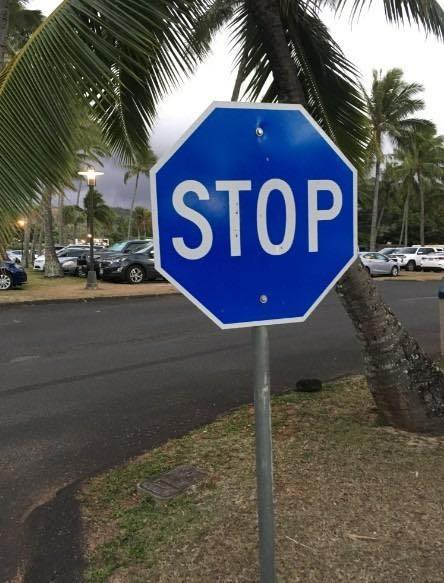ADVERTISEMENT
A **blue stop sign** is definitely an unusual sight! Traditionally, stop signs are red, and red is universally understood as a signal for stopping. However, the appearance of a blue stop sign can be confusing, as it doesn’t align with the familiar red color. So, what exactly does a **blue stop sign** mean, and is there any special significance to it?
### What Is the Traditional Meaning of a Stop Sign?
Before we dive into the blue stop sign mystery, it’s important to understand what a **standard stop sign** represents. Stop signs are a critical part of traffic control, placed at intersections to alert drivers to come to a complete stop and check for cross-traffic. The red color of the sign is universally recognized for “stop,” as red is a color that commands attention, signaling danger or a need for immediate action.
### The Mystery of the Blue Stop Sign
If you’ve seen a **blue stop sign**, it’s likely that it may have confused you at first! The blue color isn’t part of the standard color scheme for road signs, and that’s what makes it so striking. So, let’s break down what it might mean:
1. **A Misprint or Error**
– In some cases, a blue stop sign could be a **manufacturing error**. This could happen if a sign was printed with the wrong color by mistake. If the sign’s background is blue but the text still reads “STOP” in white or black, it might have been a production error or defect that went unnoticed. In these cases, the sign should still be regarded as a standard stop sign, and drivers should follow the usual rules for stopping at the intersection.
2. **Blue as a Sign of “Parking” or “Special Restrictions”**
– Another possibility is that the sign you’re looking at is not a traditional stop sign at all but may actually be related to **special parking restrictions**. For instance, blue is commonly used to indicate **parking for handicapped or disabled persons**. You may have encountered a sign that had a similar shape to a stop sign but is actually designed to convey a completely different message. In some places, local governments may use blue signs to differentiate certain parking areas, rather than the typical green or white signage.
3. **Different Country, Different Standards**
– It’s also possible that the **blue stop sign** is part of a unique traffic signaling system used in a specific country or region. While red is the international standard for stop signs in most parts of the world, **some countries or municipalities** might use a different color scheme for certain types of signs. For instance, blue might be used in countries where traffic signs are designed with different guidelines or regulations. However, this is relatively rare, and most places use red for stop signs.
4. **Special Purpose Signs**
– Another explanation could be that the blue sign is a **special purpose traffic sign** used for a specific scenario, such as an **emergency vehicle lane** or a **bus stop**. Some municipal areas may opt to use blue signs to highlight specific types of traffic or regulations. It’s worth checking with your local traffic authority or government to see if the blue sign is part of a unique set of rules in your area.
### Blue Signs in General Traffic Signage
In some countries, blue is used for specific purposes in road signs, but it’s usually not for “stop” signs. Here’s how blue signs might be used in general road signage:
– **Blue as a Service Sign**: In places like the United States, blue is often used for signs that indicate **services** available along the road, like rest stops, gas stations, or restaurants. For example, you might see blue signs guiding you to a nearby hospital or gas station.
– **Regulatory Signs**: Blue is also used for **regulatory signs** that indicate **required actions**. These could be signs like speed limits, parking regulations, or lane usage instructions. These signs are important because they provide guidance for proper behavior on the road, even though they don’t involve the immediate action of stopping, as red signs do.
For Complete Cooking STEPS Please Head On Over To Next Page Or Open button (>) and don’t forget to SHARE with your Facebook friends
